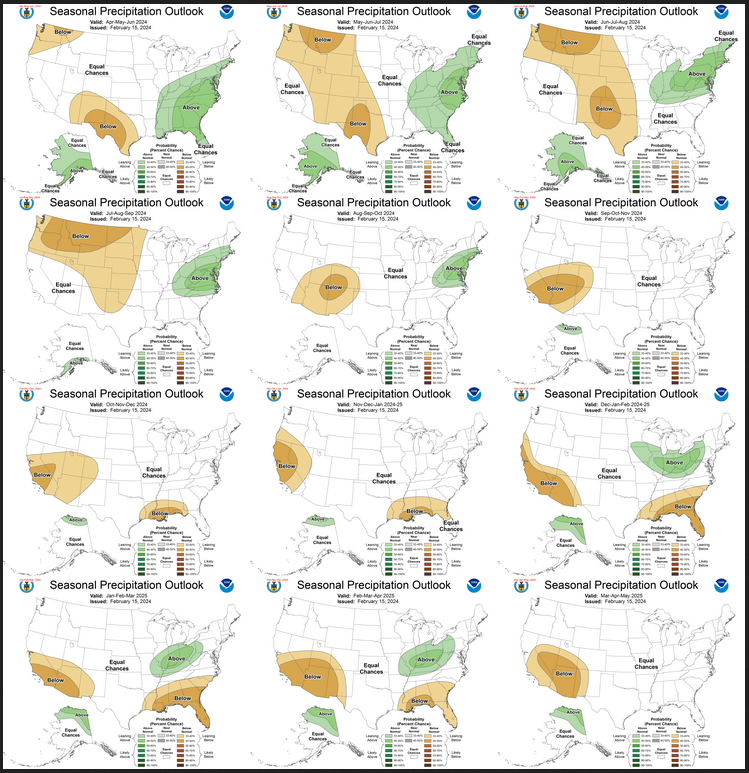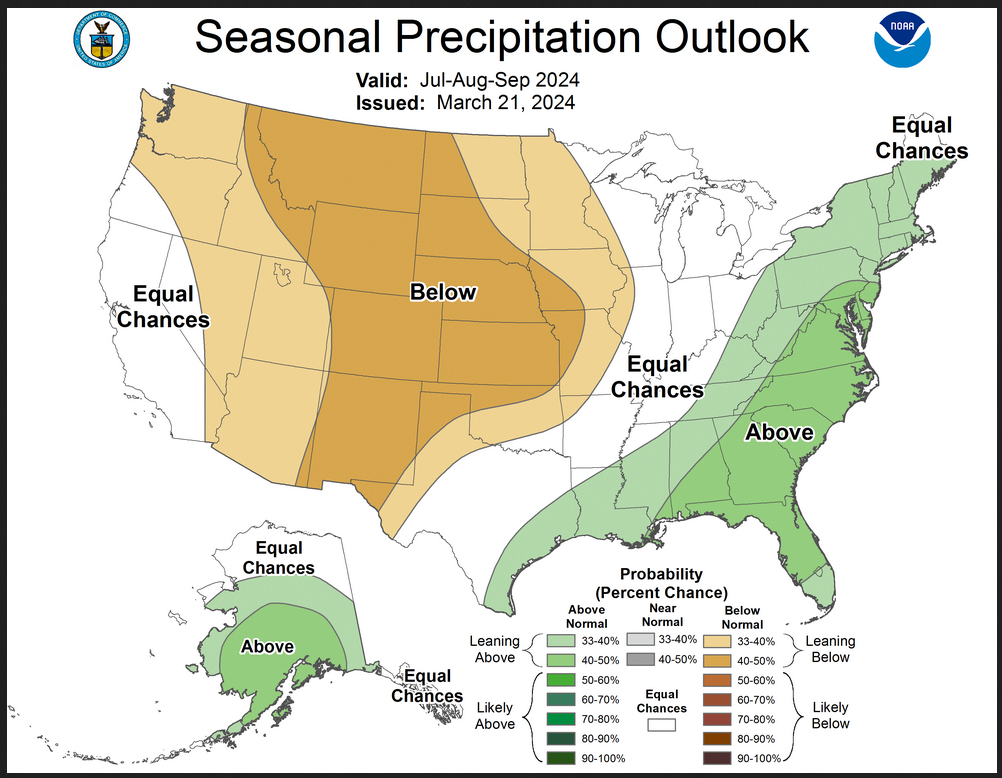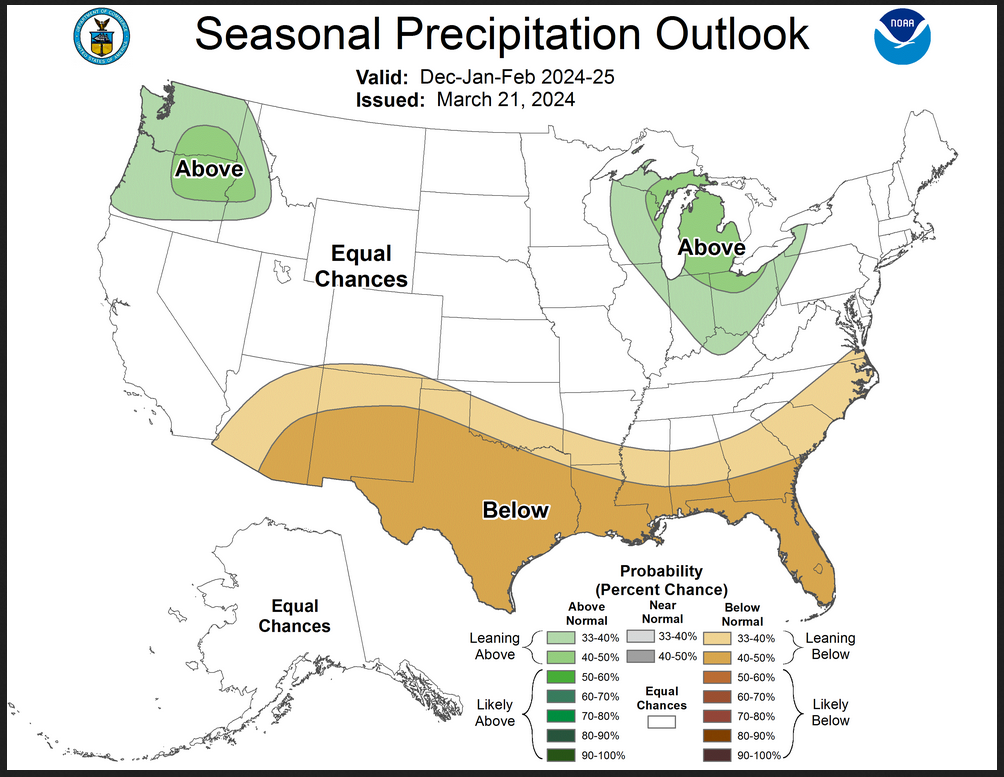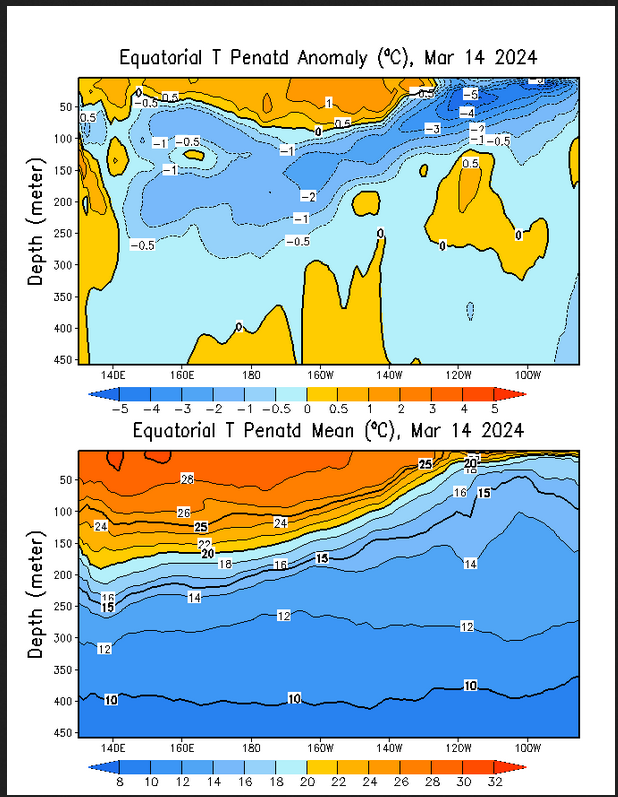Updated at 11 p.m. EDT March 22, 2024. Three additional graphics were added plus some additional commentary.
On the third Thursday of the month right on schedule NOAA issued their updated Seasonal Outlook which I describe as their Four-Season Outlook because it extends a bit more than one year into the future. The information released also included the Mid-Month Outlook for the following month plus the weather and drought outlook for the next three months. I present the information issued by NOAA and try to add context to it. It is quite a challenge for NOAA to address the subsequent month, the subsequent three-month period as well as the twelve successive three-month periods for a year or a bit more.
With respect to the long-term part of the Outlook which I call the Four-Season Outlook, there is a fairly rapid transition from El Nino to ENSO Neutral to LaNina. So getting the timing right is very challenging. The potential for a very strong La Nina is discussed but it is not the likely scenario at this point in time. But it seems that the longer-term outlook now factors in both drier conditions in certain parts of the U.S. and wetter conditions on the East Coast and Southeast this summer.
First, Let’s Take a Look at the (mid-month) Outlook for April.
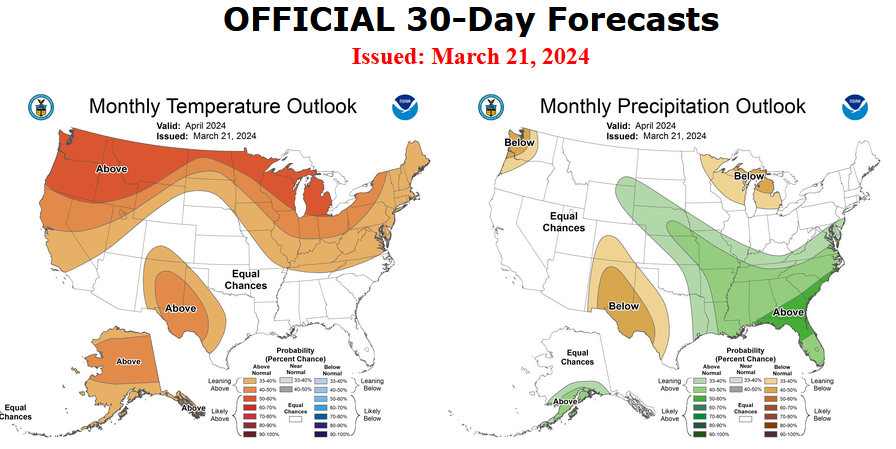
It will be updated on the last day of March

The top row is what is now called the Mid-Month Outlook for next month which will be updated at the end of this month. There is a temperature map and a precipitation map. The second row is a three-month outlook that includes next month. I think the outlook maps are self-explanatory. What is important to remember is that they show deviations from the current definition of normal which is the period 1991 through 2020. So this is not a forecast of the absolute value of temperature or precipitation but the change from what is defined as normal or to use the technical term “climatology”.
| Notice that the Outlook for next month and the three-month Outlook are somewhat different, especially with regard to temperature. This tells us that May and June will be different than April to some extent. |
The full NOAA Seasonal Outlook extends through April/May/June of 2025 (yes that is more than a year out). All of these maps are in the body of the article. Large maps are provided for April and the three-month period Apr/May/June. Small maps are provided beyond that through Apr/May/June of 2025 with a link to get larger versions of these maps.
NOAA provides an excellent discussion to support the maps. It is included in the body of this article. In some cases, one will need to click on “read more” to read the full article. For those on my email list where I have sent the url of the article, that will not be necessary.
Here are larger versions of the Temperature and Precipitation Outlook maps for next month.
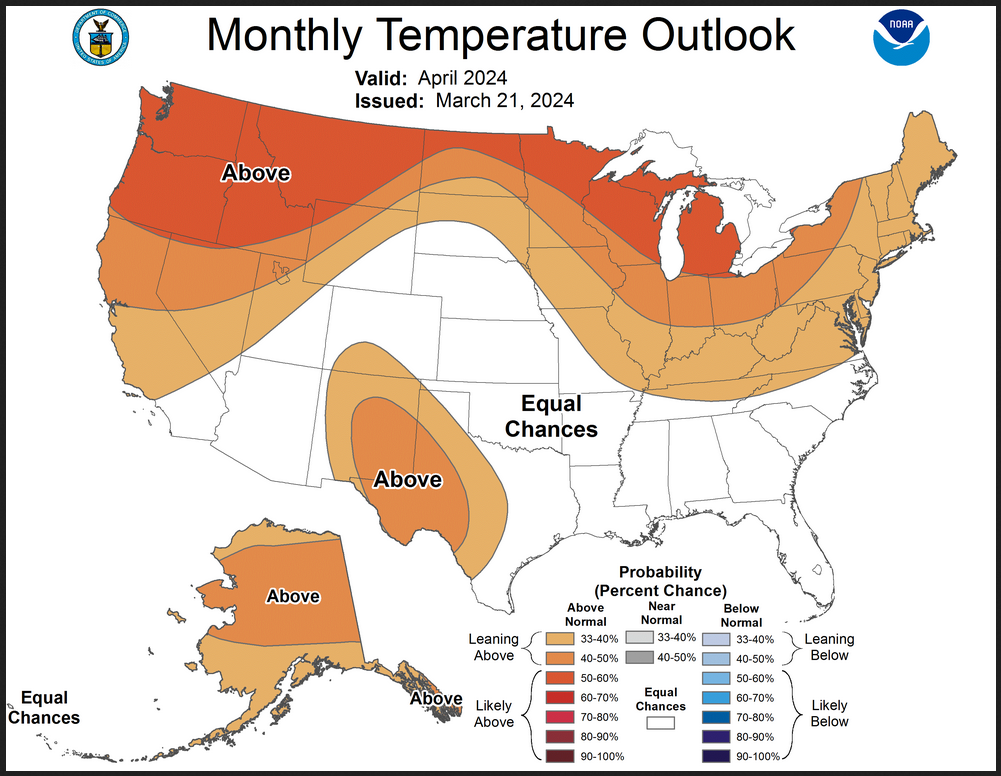
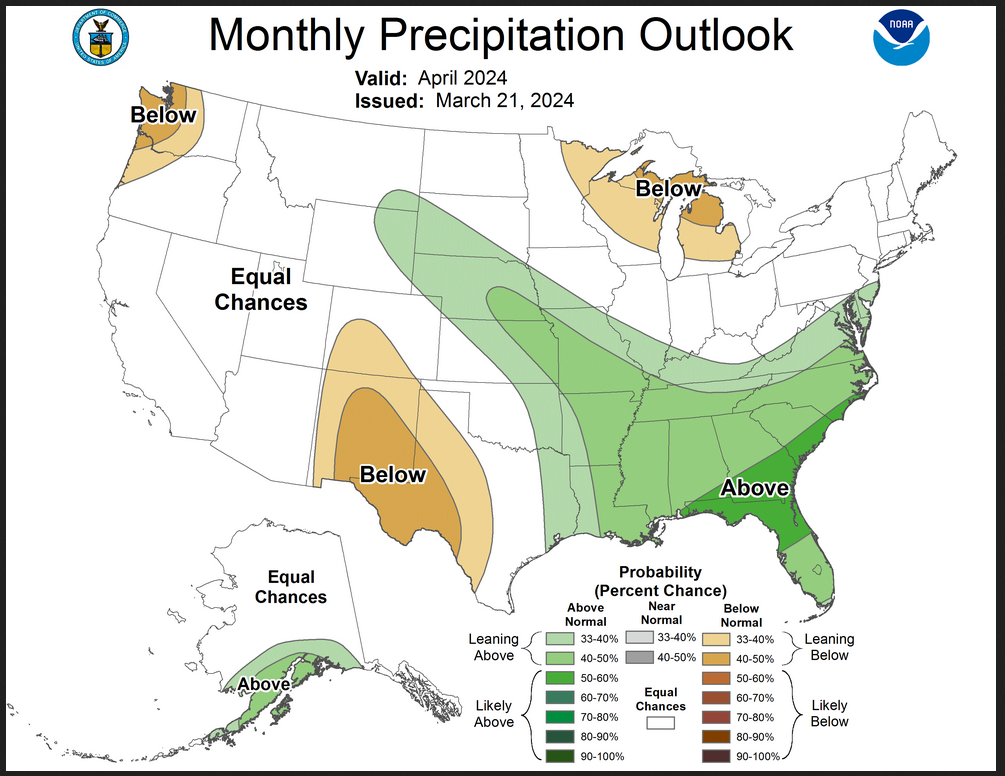
The maps are pretty clear in terms of the outlook.
And here are large versions of the three-month AMJ 2024 Outlook
First temperature followed by precipitation.
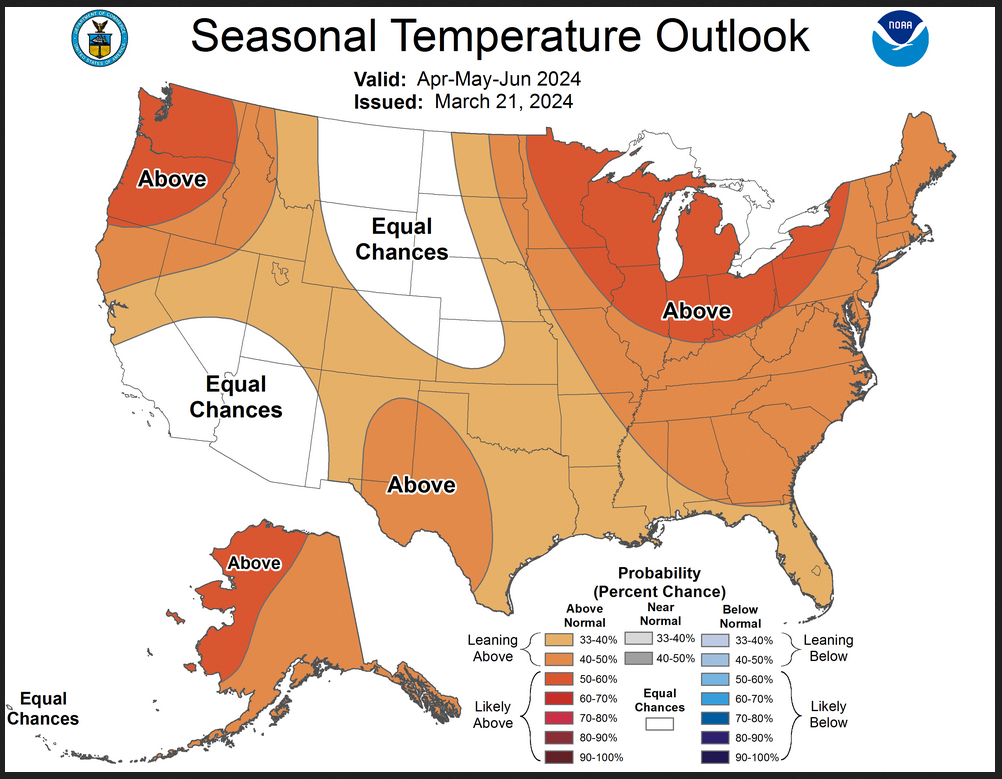
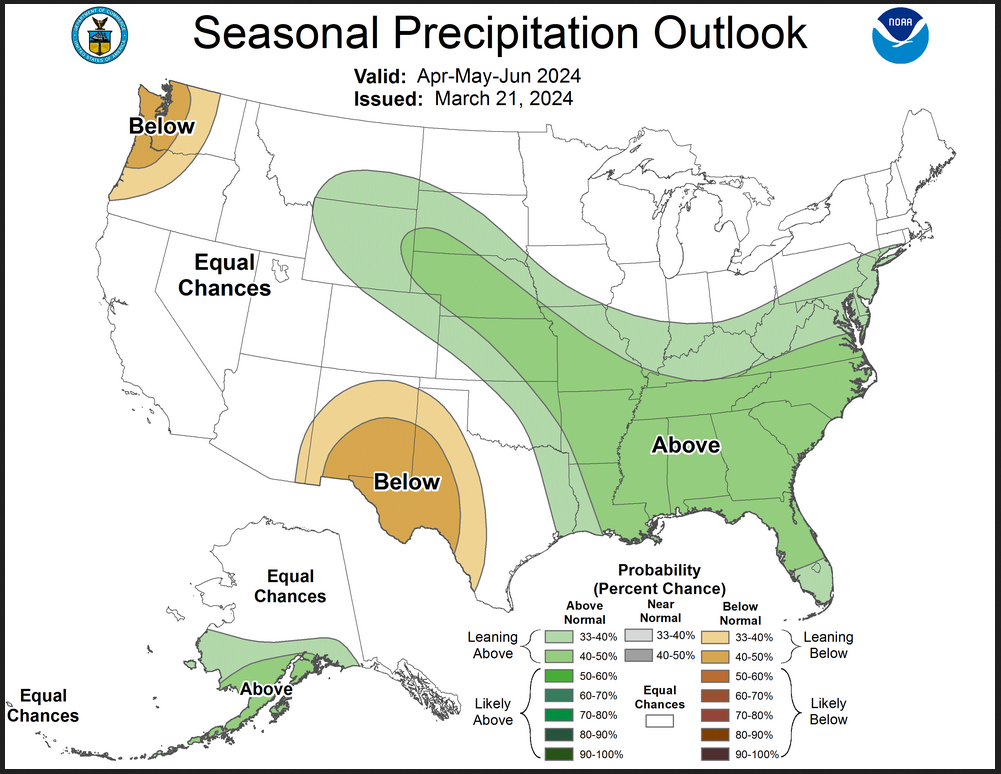
| These maps are larger versions of what was shown earlier. |
Drought Outlook
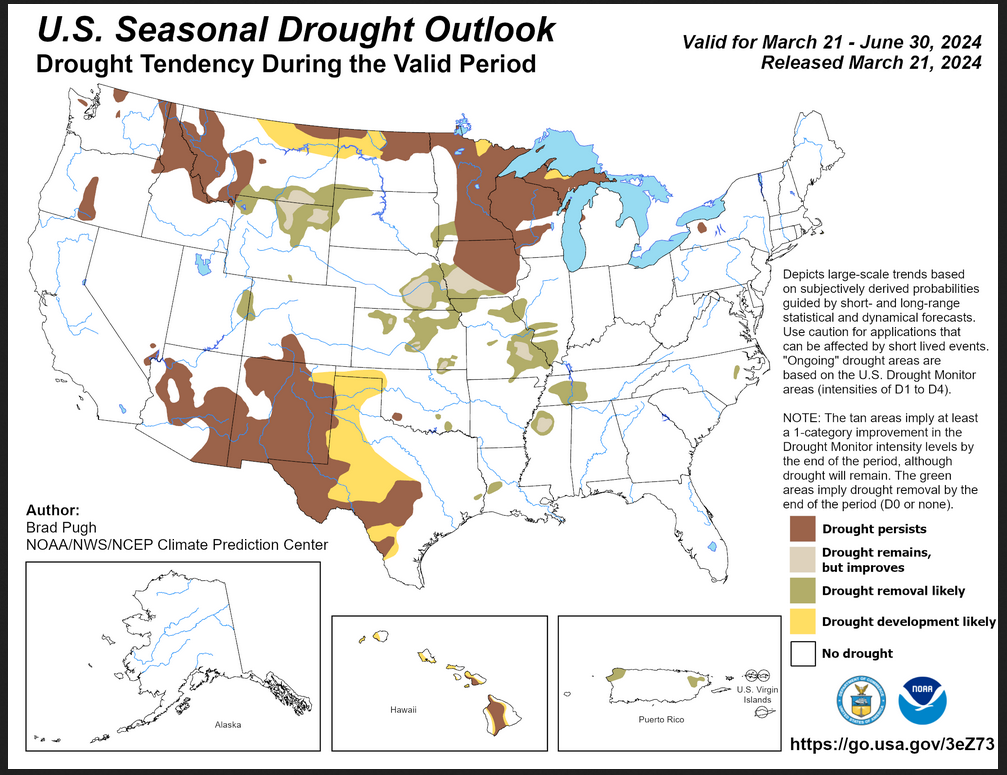
| The yellow is the bad news and there is also a fairly large area where drought removal or lessening is likely to happen. But there is a large area where drought is expected to persist. Overall the level of drought is expected to remain about the same. But those living in Arizona and Mexico might have expected more drought relief from a very strong El Nino. Puerto Rico is not happy with this outlook. |
Short CPC Drought Discussion
Latest Seasonal Assessment – Typical for an El Niño winter, major drought improvements occurred across the Southeast, lower Mississippi Valley, and Gulf Coast since December 2023. These improvements, albeit less in magnitude, extended westward to the southern to central Great Plains and Southwest. Based on the April-May-June (AMJ) precipitation outlook, additional drought improvement or removal is forecast across the central Great Plains and middle to lower Mississippi Valley. AMJ is an increasingly wet time of year for the central Great Plains which was another factor in this seasonal drought outlook.
Drought has either expanded or intensified throughout the Upper Mississippi Valley during the 2023-24 winter. Broad-scale persistence is forecast for this region given the long-term drought and the AMJ outlook calling for equal chances (EC) of below, near, or above-normal precipitation. However, forecast confidence is low across Iowa, Minnesota, and Wisconsin where heavy precipitation (rain and snow) may occur during late March. Drought persistence or development is forecast for North Dakota, much of Montana, and northern Idaho due to the lack of winter snowfall and absence of a robust wet signal in the seasonal precipitation tools. Consistent with an increasingly drier climatology later this spring and the AMJ precipitation outlook, persistence is forecast for Oregon and Washington.
Forecast confidence is high for development across parts of the southern high Plains as short-term dryness increases and the AMJ outlook favors below-normal precipitation. Persistence is likely for ongoing drought areas across Texas. A much drier climatology later this spring supports broad-scale persistence for the Southwest.
Alaska is expected to remain drought-free through the end of June. As dryness associated with El Niño lingers into the spring, persistence or development is forecast across Hawaii. Puerto Rico is likely to have continued drought removal, while the U.S. Virgin Islands remain drought-free.
Looking out Four Seasons.
Twelve Temperature Maps. These are overlapping three-month maps (larger versions of these and other maps can be accessed HERE)
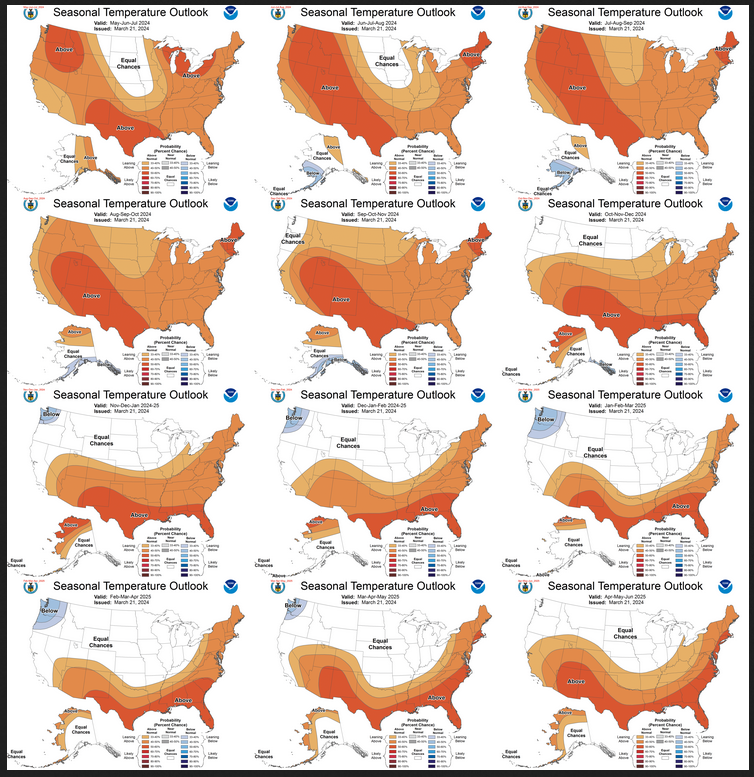
Notice that this presentation starts with May/June/July 2024 (MJJ) since AMJ is considered the near-term and is covered earlier in the presentation. The changes over time are generally discussed in the discussion but you can see the changes easier in the maps.
Comparing the new outlook with the prior Outlook,
The 12 temperature maps were issued last month.
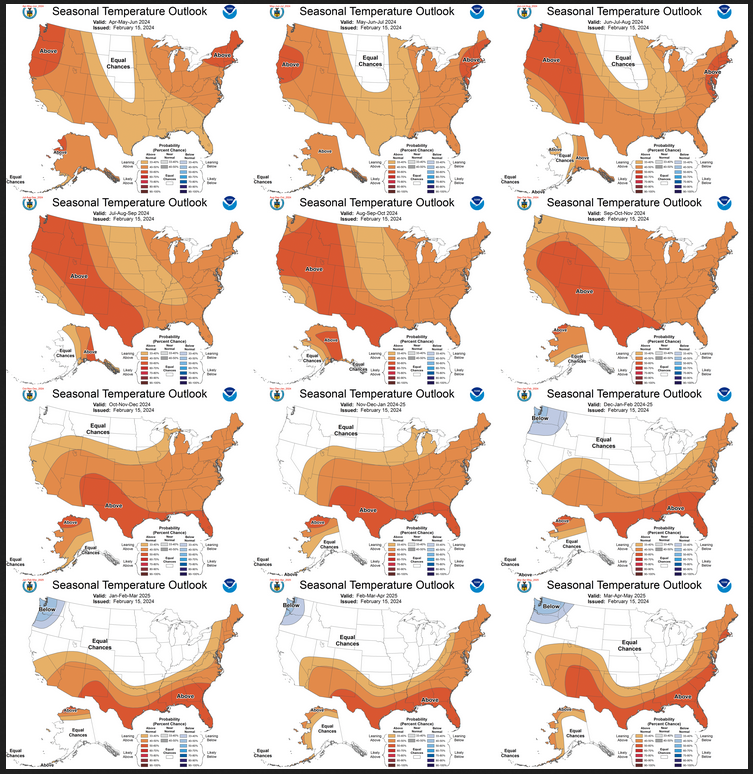
The easiest way to do the comparison is to print out both maps. If you have a color printer that is great but not needed. What I do is number the images from last month 1 – 12 starting with “1” and going left to right and then dropping down one row. Then for the new set of images, I number them 2 – 13. That is because one image from last month in the upper left is now discarded and a new image on the lower right is added. Once you get used to it, it is not difficult. In theory, the changes are discussed in the NOAA discussion but I usually find more changes. It is not necessarily important. I try to identify the changes but believe it would make this article overly long to enumerate them. The information is here for anyone who wishes to examine the changes. I comment below on some of the changes from the prior report by NOAA and important changes over time in the pattern.
| It is difficult to identify the changes in the temperature pattern because most of the changes are changes in the likelihood of it being warmer than climatology. |
Now the Twelve New Precipitation Maps
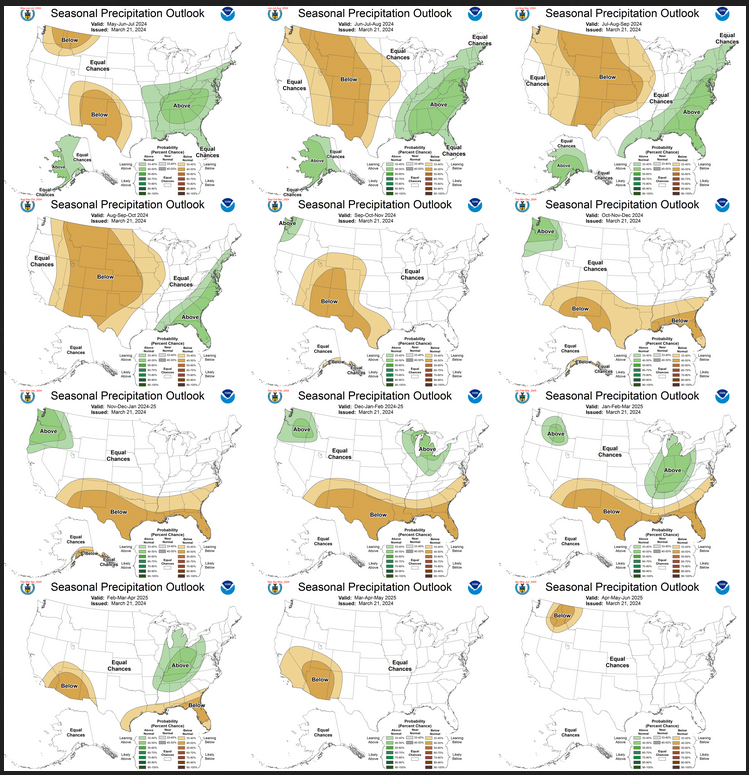
Similar to Temperature in terms of the organization of the twelve overlapping three-month outlooks.
Comparing the new outlook with the prior Outlook,
The maps that were released last month.
A good approach for doing this comparison is provided with the temperature discussion.
| The overall outlook is drier. It is fairly well described in the NOAA Discussion. Below are images of two representative three-month outlooks that illustrate the pattern. |
| The bottom winter map suggests a more northern Jet Stream. I do not know how to interpret the summer map. It includes a failed monsoon but the dry anomaly covers a large area as does the wet anomaly. |
NOAA Discussion
Maps tell a story but to really understand what is going you need to read the discussion. I combine the 30-day discussion with the long-term discussion and rearrange it a bit and add a few additional titles (where they are not all caps the titles are my additions). Readers may also wish to take a look at the article we published last week on the NOAA ENSO forecast. That can be accessed here.
I will use bold type to highlight some especially important things. All section headings are in bold type; my comments, if any, are enclosed in brackets [ ].
CURRENT ATMOSPHERIC AND OCEANIC CONDITIONS
El Niño is rapidly weakening as equatorial Pacific Ocean sea surface temperatures (SSTs) continue to cool with anomalies in SST near zero for parts of the equatorial eastern Pacific. The most recent weekly value of the Niño3.4 SST index is +1.1 degrees C. Below the surface along the equator, the 0-300 meter depth temperature anomaly (i.e., integrated heat content) is now negative. Significant areas of cooler than normal water temperatures are observed at depth across much of the basin, and especially in the eastern Pacific, where a reservoir of anomalously cold water is present just below or at the surface from 120 W eastward to the South America coast with the maximum anomaly surpassing -6.0 degrees C.
Although the oceanic indicators for El Niño have decreased in the Pacific Ocean, there does remain some atmospheric El Niño signature, and it will likely take some time for this response to completely disappear. For example, in the past 30-day average, suppressed convection remained present for some parts of the Maritime continent, and enhanced convection was present in proximity to the Date Line along and near the equator. Moreover, upper-level anti-cyclonic circulations, symmetric about the equator in both hemispheres, are evident. Trade winds are increasing in magnitude with weakening El Niño conditions.
An expansive area of below-normal snow cover and depth is present from the northern Plains eastward to the Great Lakes and Northeast. Above-normal soil moisture is present in many areas this March – including areas in California and other parts of the West as well as for the eastern seaboard. Drier than normal soils are evident near the far northern Plains, upper Midwest, Great Lakes, Ohio Valley and Southwest.
PROGNOSTIC DISCUSSION OF SST FORECASTS
Forecasts of the Niño3.4 SST index from the NMME are in good agreement for a rapid transition to near zero (i.e., no anomaly) during AMJ 2024 and increasingly negative anomalies less than -1.0 degrees C by ASO 2024. The NMME ensemble mean forecast enters La Niña territory (less than -0.5 degrees C) approximately during July 2024.
The CPC Niño3.4 SST consolidation forecast follows a similar trajectory as the NMME ensemble mean crosses into La Niña territory at a similar season. The CFS and the CA models show the most negative values and potentially a stronger La Niña event. The CFS model would be considered an outlier at the current time however, as it predicts a strong event with a Niño3.4 index value less than -2.0 degrees C by SON 2024. [Author’s Note: I assume when they say less than -2.0C they mean the Nino 3.4 Index would be more negative than -2.0]
The official CPC ENSO outlook favors ENSO neutral through the MJJ season with La Niña favored thereafter increasing to near 85% likelihood by SON 2024.
30-DAY OUTLOOK DISCUSSION FOR APRIL 2024
The April 2024 monthly temperature and precipitation outlooks are based on various climate factors (such as ENSO and to some degree, the Madden-Julian Oscillation (MJO)), boundary conditions (snow depth and soil moisture), dynamical and statistical model guidance, and historical temperature and precipitation trends .
Sea-surface temperature (SST) anomalies across the central and eastern equatorial Pacific have significantly decreased during the past few weeks, and a relatively small extent of anomalously cool water has appeared over the eastern Pacific related to the upwelling phase of an oceanic Kelvin wave. Cooler-than-average subsurface temperatures have developed over much of the eastern Pacific. By mid-March, enhanced trade winds have returned to a large portion of the equatorial Pacific. All these factors are consistent with a rapidly weakening El Nino, which has been in place for just over one year. El Nino is forecast to transition to ENSO-neutral during the April-May-June (AMJ) season. However, El Nino impacts are expected to linger well into the month of April across the United States, and these expected impacts were considered in the construction of the April outlook. Another climate factor to consider is the currently robust MJO. The enhanced convective phase of the MJO is located over the Western Pacific (Phase 7 in RMM space), and the suppressed phase of the MJO is located over the Indian Ocean (Phases 2 and 3 in RMM space). Model forecasts of the MJO index propagate the MJO signal into the Western Hemisphere over the next two weeks. Within the first week of April, lagged MJO composites for Phase 7 favor anomalously cool temperatures over at least the central third of the contiguous U.S. (CONUS).
In addition to the climate factors noted above, there is an extensive area of anomalously low snow depth from Montana eastward across the Northern Great Plains, Great Lakes region, and Northeast. From eastern Montana across the Northern Plains snow depth departures are generally 8 inches or less, though in the vicinity of Great Falls, Montana, snow depth departures range from 2-3 feet (locally greater) below normal. From the Upper Mississippi Valley eastward across the Great Lakes and New England snow depth ranges anywhere from 8-30 inches below normal. Unusually low snow depth means less water will be available for staggered release into soils during the beginning weeks of the growing season. Much of this region is also experiencing relatively low soil moisture values. The exception is the Northeast, where recent precipitation has resulted in ranked soil moisture percentiles in excess of the 95th percentile.
Temperature
For the April temperature outlook, there are elevated chances for above-normal temperatures from most of the West Coast states eastward and northeastward into the Northern Plains, continuing eastward and now southeastward across the Upper and Middle Mississippi Valley, Great Lakes region, Ohio Valley and neighboring portions of Tennessee, most of the Appalachians, and the Atlantic coastal plain from Maine to northern North Carolina. The favored above-normal temperatures are generally supported by the Final Consolidation tool (Final-CON) which skill-weights a consolidation of dynamical models (NMME-CON) and a consolidation of statistical models (Stat-CON). These temperatures are also generally supported by the Constructed Analog on Soil Moisture Tool (CA-SMT), and to a lesser degree the International Multi-Model Ensemble (IMME, also referred to as C3S or Copernicus), CFS, calibrated NMME (PAC), and GFDL SPEAR models. Most of the favored above-normal temperatures were derived from dynamical model guidance rather than statistical model guidance. Expected lagged El Nino impacts also played a role in this forecast, as well as above-normal SSTs along the West Coast. The boundary conditions noted earlier played a significant role in the temperature forecast from Montana eastward across the Great Lakes and Northeast. The probabilities favoring above-normal temperatures across New England and eastern New York state were tempered by anomalously high soil moisture values. The 15-year Optimal Climate Normals (OCN) temperature tool, a proxy to the last 15 years of historical temperature trends, favored relative warmth across portions of the Far West, Four Corners states, southern Texas, and the Mid-Atlantic and Northeast coastal plain. There are increased chances for above-normal temperatures over the southern Rockies and southern High Plains, associated with anomalously dry soils, the three CON tools (noted above), and a high sun-angle. Most model guidance supported above-normal temperature chances for most of Alaska, with the exception of the Aleutians where Equal Chances (EC) of below, near, and above-normal monthly mean temperatures are favored.
Precipitation
The April precipitation outlook is based on the same climate factors, boundary conditions, and model guidance as the April temperature outlook. Wetter-than-normal conditions are favored from approximately the southeastern quadrant of the CONUS northwestward into the north-central High Plains. This is generally consistent with the Final and NMME CONs, uncalibrated NMME, IMME, historical precipitation trends , and lagged El Nino impacts. Well below-normal snow depth, anomalously low soil moisture, and expected lagged El Nino impacts favor below-normal precipitation for the Upper Great Lakes region. Anomalously low soil moisture, high sun-angle, and guidance from the Final and Stat CONs favor below-normal precipitation across southwestern Colorado, New Mexico, and most of West Texas. Below -normal precipitation is also favored for parts of the Northwest, based on model support and lagged El Nino impacts. In Alaska, there were significant differences in the precipitation forecasts, though the IMME, GFDL SPEAR, and Canadian CanCM4i models supported an elevated chance of above-normal precipitation across the southern part of the state, including the Alaska Peninsula.
SUMMARY OF THE OUTLOOK FOR NON-TECHNICAL USERS (Focus on April through June)
During mid-March 2024, an El Niño Advisory remains in effect, but El Niño ocean conditions are rapidly weakening and ENSO neutral is most likely to be in place by the end of the April-May-June (AMJ) season. A La Niña Watch is also in effect as La Niña conditions are favored to develop by summer and continue through autumn 2024.
Temperature
The AMJ 2024 temperature outlook favors above-normal seasonal mean temperatures for Alaska, much of the Far West, the southern Plains and the eastern half of the CONUS. Greatest odds for warmer than normal temperatures is shown for northwest Alaska, the Pacific Northwest and in proximity to the Great Lakes. No areas of favored below-normal temperatures are forecast for Spring 2024.
Precipitation
The AMJ 2024 precipitation outlook favors above-normal seasonal total precipitation amounts for portions of southern Alaska and for a region from the northern High Plains southeastward across the central Plains to include the Southeast and mid-Atlantic. Below-normal precipitation is most likely for parts of the Pacific Northwest and Southwest.
Equal chances (EC) are indicated for areas where seasonal mean temperatures and seasonal total precipitation amounts are favored to be similar to climatological probabilities.
BASIS AND SUMMARY OF THE CURRENT LONG-LEAD OUTLOOKS
PROGNOSTIC TOOLS USED FOR U.S. TEMPERATURE AND PRECIPITATION OUTLOOKS
Given some likely remaining El Niño atmospheric response during April 2024, typical El Niño impacts are considered to some degree very early in this set of outlooks (i.e., AMJ 2024). Current anomalous soil moisture and snow cover/depth are considered and contributed substantially to the outlook in some locations during the AMJ season – primarily across areas of the north where well below-normal snow cover and depth are present and in parts of the Midwest and Southwest where soils are dry.
Dynamical model forecasts from the NMME and C3S multi-model ensemble systems are utilized, as is the Calibration, Bridging and Merging (CBaM) tool anchored to the NMME forecasts and “bridged” with the Niño3.4 index – primarily for temperature outlooks. The CA statistical tools based on SST and soil moisture respectively along with the ENSO-OCN forecast tool that targets impacts from ENSO as predicted by the CPC consolidation Niño3.4 SST forecast and long term trends played a large role in many of the outlooks.
La Niña impacts are considered in the outlooks from JJA 2024 through JFM 2024-2025. Natural analogs for years that underwent a transition from El Niño to La Niña during a similar portion of the seasonal cycle are also explored.
PROGNOSTIC DISCUSSION OF OUTLOOKS – AMJ 2024 TO AMJ 2025
TEMPERATURE
The AMJ 2024 temperature outlook favors above-normal seasonal mean temperatures for most of the U.S. with the exception of some areas of the Southwest U.S. and the northern and central High Plains. The greatest odds of above-normal temperatures is for parts of the Pacific Northwest, northwest Alaska and the Great Lakes region. The AMJ outlook does not highlight any favored areas for below-normal seasonal mean temperatures.
Residual El Niño impacts, positive temperature trends , above-normal coastal SSTs and dynamical model guidance from both the NMME and C3S systems support warmer than normal conditions in the Pacific Northwest as well as much of the eastern CONUS. Odds are highest in the Great Lakes area due to additional likely impacts from antecedent surface conditions such as below-normal snow cover extent and depth, dry soils in some areas, and warmer than normal Great Lakes. Dry soils also result in a local maximum in probabilities for above-normal temperatures for parts of Texas and New Mexico. Residual impacts of El Niño (potential troughing and cooler conditions) primarily early in the season, and conflicting or weaker climate signals result in a forecast of equal chances (EC) for areas in the Southwest and northern and central High Plains.
Negative trends in sea ice coverage and thickness and so more open water earlier than normal for ocean areas along the western and northern coasts of Alaska and statistical and dynamical model guidance favor above-normal temperatures for most of the state of Alaska for AMJ 2024.
Progressing through the MJJ through JAS 2024 temperature outlooks, odds for above-normal temperatures increase across the western and southern CONUS as there is nearly unanimous and consistent agreement from NMME and C3S dynamical model guidance. There remains more uncertainty for parts of the north central U.S. through JJA 2024 so EC is forecast in this area.
The anticipated transition to La Niña entering summer 2024 supports gradually increasing forecast coverage and odds for above-normal temperatures for the Midwest during JAS 2024 and ASO 2024. Thereafter, considerations for the slow development of typical La Niña impacts (supported by La Niña composites, regressions, and statistical forecast tools) during the autumn and winter months are the reasons for the forecast evolution through FMA 2025. This includes decreasing odds for above-normal temperatures and then EC for much of the northern tier of the U.S. through OND 2024 and the introduction of favored below-normal temperatures for the Pacific Northwest in NDJ 2024-2025 through MAM 2025. Moreover, above-normal temperatures are favored for the southern half of the U.S. and along the eastern seaboard over this period.
For Alaska, the transition from El Niño to favored La Niña conditions results in decreasing odds for above-normal temperatures from west to east through JAS 2024 with the introduction of favored below-normal temperatures for the southwest part of the state. This orientation is adjusted north to south through OND 2024 with above-normal temperatures most likely for the northern part of the state and below-normal temperatures favored for southern coastal areas.
PRECIPITATION
The AMJ 2024 precipitation outlook favors above-normal seasonal total precipitation amounts for the Southeast, lower Ohio Valley, mid-Atlantic and parts of the central and northern High Plains. Residual El Niño influence, long term positive precipitation trends as defined by OCN, dynamical model guidance from the majority of the participant models of the NMME and C3S ensemble systems support this forecast. Below-normal precipitation is favored for parts of the Pacific Northwest due to residual El Niño influence and dynamical model guidance. Dynamical and statistical forecast tools support elevated odds for below-normal precipitation for areas in the Southwest.
Thereafter, there is a rapid transition to strong dry signals from MJJ through ASO 2024 for the eastern Southwest monsoon region to the interior of the contiguous U.S. This is consistent with developing La Niña conditions and associated potential impacts and is supported very strongly by strong signals of favored below-normal precipitation from the NMME and C3S dynamical forecast guidance. The outlooks highlight rather large forecast coverage of below-normal precipitation for many areas of the western and central CONUS.
Thereafter, favored drier than normal conditions shift to the southern tier of the U.S., associated with a La Niña response during the cool season from SON 2024 through FMA 2025. Over the same forecast period, above-normal precipitation is most likely for the Pacific Northwest and areas in the Ohio Valley and Great Lakes region with maximum coverage and odds during the NDJ 2024-2025 and JFM 2025 seasons respectively.
For Alaska, above-normal precipitation is favored during the warm season through JAS 2024. Later in the set of outlooks, a slight tilt toward below-normal precipitation is forecast for the southeast areas of the state including portions of the Panhandle from SON 2024 through NDJ 2024-2025.
The key piece of information used by NOAA follows.
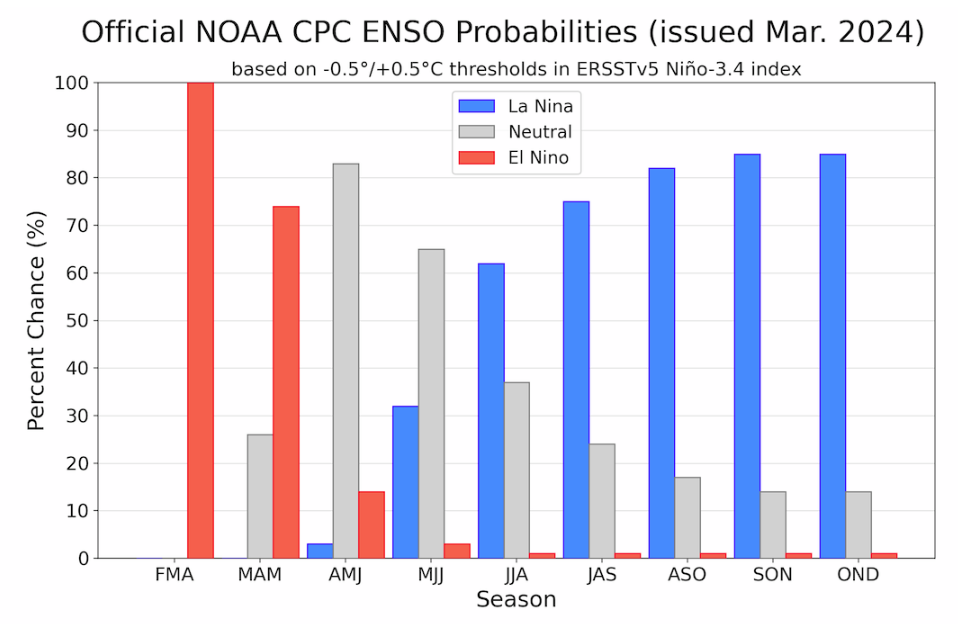
| It looks like El Nino early in the forecast period. It does start to begin to reduce the intensity in MAM2024. There is increasing confidence that this El Nino will weaken in the Spring into the summer which is shown here as the probabilities of El Nino rapidly converge with the probabilities of ENSO Neutral and then La Nina in the later part of the forecast period. The above graphic does not extend into the future as far as the outlooks presented in this article. That can be confusing. |
| It is west of 120W that is of most interest. The bottom map is the actual water temperature and NOAA places importance on 25C which reaches the surface just to the west of 120W. The top graphic deals with differences from normal or anomalies. It is below 0C to the west of 12W but only partially towards 170W so only part of the Nino 3.4 Measurement area is in La Nina territory and when averaged out it is still El Nino. But look at some of those anomalies: -5C -4C etc are impressive. I do not think we have had a winter with the Nino 3.4 index below -2.0. Three-month averages are called the ONI or Oceanic Nino Index. It is measured at the surface not below the surface. |
Resources
–
| I hope you found this article interesting and useful. |
–

